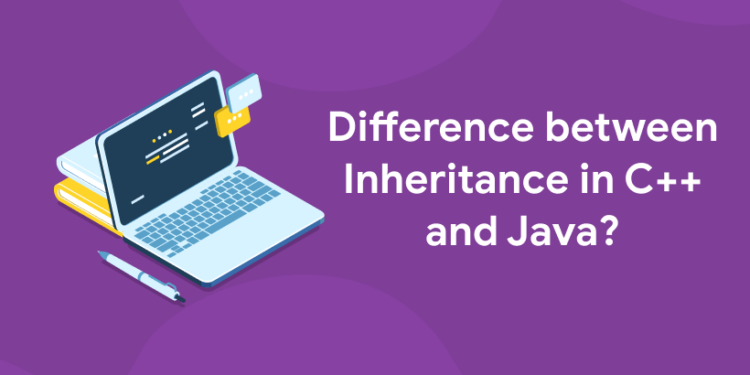Table of Contents
Java and C++ are both object-oriented programming languages, so they have many similarities. Multiple inheritances, however, are not one of them. In this article, you’ll learn what types of inheritance in Java are and how it compares to the equivalent feature in C++. Java developers who are used to the way multiple inheritances work in C++ may be surprised by how it works in Java. The two languages’ implementations of multiple inheritances differ in several key ways, which can be problematic if you’re not aware of what to expect when writing code that uses this feature. Multiple inheritance in java allows you to inherit from more than one class at the same time in Java and C++. Java, however, has some very strict rules to follow, while in C++ you have some flexibility with what you can do and how your code will be written to support multiple inheritances. Let’s go over some of the key differences between multiple inheritances in Java and C++. Multiple inheritance in Java and C++ may seem similar at first glance, but there are some key differences that can have serious consequences depending on the way you use them.
C++: Multiple Inheritances
1: What is the default value of a boolean in Java?
The types of inheritance in C++ are discussed in the article. The ability to derive from more than one parent class. This is called multiple inheritance in Java. For example, a child inherits from both a Dog and a Cat. Only single inheritance: A derived class can inherit from only one base class (single inheritance). Multiple interfaces: To implement multiple interfaces (multiple inheritances) you need to use pointers, array and function pointer,s etc that are not available in java. Constructor overloading: You can overload constructors to define your own constructor rules, but again it’s not available for java. All of these features are there in java but with a slight difference, Java supports single inheritance from one class. In other words, you can’t derive from two classes or if there is any case of derivation then it should be extended either directly or through an interface (Java does support Interface Inheritance). Multiple-inheriting – It doesn’t have multiple inheritances either because of its static typing or because of its implementation language as mentioned above. However, we can achieve multi-inheriting by using interfaces. Constructor overloading – You cannot overload constructors for your own classes in Java; however, you can do so for inherited classes (i.e., base class) by using super keyword to call the constructor of the base class and passing parameters to that constructor just like a normal method call. This feature is also not available for C++ because it has no concept of a super keyword that calls methods based on their position relative to the current method location rather than relative to the class hierarchy. Polymorphism: Polymorphism means having many forms which means the same functionality applied differently depending upon conditions. These are the types of inheritance in C++.
Learn Coding in your Language! Enroll Here!
C#: Multiple Implementations
Multiple inheritance in java are supported by C#. However, since it can lead to ambiguities, programmers must not use it. The following are some of its limitations: A class can inherit from only one class but a class can implement multiple interfaces. But a class implementing multiple interfaces has to implement every method of all these interfaces. This is why classes implementing multiple interfaces are often declared abstract so that they cannot be instantiated and treated as black boxes which expose their methods without knowing their internal implementation details. A better approach to using more than one interface together with inheritance is composition rather than inheritance in such situations. Composition allows combining two or more classes together into a new class while keeping them separate and independent from each other. It also allows for easy replacement of one class with another similar one if needed. Polymorphism is achieved through virtual functions, instead of virtual base classes or virtual inheritance (as in C++), or types of inheritance in java (as in Java). Virtual functions allow for run-time binding at runtime based on actual type information, whereas virtual base classes and interfaces require compile-time binding based on type information available at compile time. Thus polymorphism through virtual functions gives dynamic dispatch while polymorphism through virtual base classes or interfaces gives static dispatch. However, there is no distinction between public, protected, and private members in C#. All members are public by default. There is no access specifier like protected or private. In addition, inheritance is always public inheritance because private and protected inheritance does not exist in C# language.
Enroll in our latest java programming course in the Entri App!
Extend Class
Once you create a subclass of a class, you inherit all of its functionality. Thus, any method that your parent class has already defined will also be defined by your new subclass. This is called method overriding. In order to implement method overriding, the child class must override (redefine) a parent’s method with one with identical arguments and return types. Otherwise, if you define a new method in your child’s class with different argument types or a different return type from that of its parent’s equivalent method, it is termed an overloaded version of that method. That is because overloading allows for more than one implementation of some methods depending on their arguments. An example of method overriding would be if you were creating a subclass of Animals called dogs. You would have access to all Animal methods, but could then add additional functionality specific to dogs. For example, you might want to include dog-specific behavior such as fetching sticks or barking. To do so, you can just redefine those methods within your Dog class. If there are multiple definitions of a method in two classes—one inherited from a parent and another in a subclass—the definition that occurs later wins out. This is known as overriding inheritance.
Subclass Class
In java when you want to make a new class that inherits from the old class then it is done by keyword extends. In c++ there is no keyword for that instead we use colon signs like A:B or a:b which means A is subclass of B or a is a subclass of b. Unlike java where subclass inherited all properties from the superclass, in c++ we can define some properties only available to subclass & some properties that are only available to superclass. This is done using public, protected & private keywords. This helps us to create more readable code. Like if we have two classes, Parent & Child. If a child wants to access parent property it will be easy with these keywords as a child can access parent property without having access specifier while accessing other class property it has to have the same access specifier as a superclass. So it’s helpful in keeping your code more readable. Also when you create a constructor using the super keyword in java , constructors of superclass also get called but in c++ constructors of the base class won’t get called unless they are explicitly defined. So now we know what inheritance is but how do we achieve polymorphism? There could be multiple ways but one simple way is by creating abstract base class where every method must implement by derived class. And so child classes get polymorphic behavior without any explicit cast.
Super keyword
inheritance;c plus; java programming language; java programming tutorial;difference between inheritance in c plus plus and java; the difference between class and interface in java; the difference between abstract class and interface in java; difference between abstract class and interface;abstract class vs interface in java. Abstract Class vs Interface Difference: The main difference is that an abstract class can contain the implementation of some methods, while an interface cannot. A more detailed explanation is given below: Abstract Class: An abstract class is a special kind of class that contains one or more pure virtual methods. It means that it cannot be instantiated directly. You can use an abstract class to declare a contract for any derived classes, but you must define all its pure virtual methods by implementing them in concrete derived classes. In other words, an abstract class acts as a blueprint from which you derive other classes. If you don’t override these pure virtual methods then your derived class will also become abstract. Interface: An interface is nothing but a collection of method declarations with no implementation. Interfaces are used to specify how objects interact with each other without providing specific details about how they do so or what data types they use.
Overriding Methods
In Java, overriding is done exactly like it is in C#, with a virtual keyword and specifying which method you’re overriding. In C++, however, it’s more complicated; as you may have guessed from our earlier discussion of multiple inheritances (if X inherits from A and B then both A::virtualMethod() and B::virtualMethod() are valid), because of multiple inheritances, there has to be a way to specify which parent method you want to use. This is done with something called dynamic binding or polymorphism; if we call A::virtualMethod(), execution will jump to whichever implementation is most appropriate for that type. For example , if you call A::virtualMethod() on an instance of X, it will look at what class X actually inherits from, find that it inherits from both A and B, and run either A::virtualMethod() or B::virtualMethod(). It does not matter whether you declare your methods virtual; only whether they are declared in a base class. If no override is found during dynamic binding, an error occurs: class Y does not implement interface Z. Note that Java doesn’t support multiple inheritances, so when talking about inheriting a method from another class it really means implementing an interface. That’s why in java you can write public void foo(){} and still have access to its implementation through super(foo); without declaring your own version of foo() as abstract. Also note that all these rules apply to properties too! Overriding property getters/setters work just like overriding methods except using property instead of virtual/abstract, so if I say public int x {get; set;} I’m telling my compiler please don’t let me do anything here. The compiler will warn me about trying to do something and tell me I need to add an override somewhere before I compile again.
Overloading Methods
In C++, you can overload methods by declaring multiple methods with the same name but different arguments. In Java, you can’t overload a method simply by changing its signature; instead, you must create a new method with a different name and then refer to it as if it were an overloaded method. This difference may seem subtle, but it means that for every new type that you want to add to your code (for example), you need to actually write more code in Java than in C++! The upshot is that all of your methods are virtual: they can be overridden or extended at runtime. This makes code extensibility easier when working on large projects like frameworks. For example, Spring uses annotations extensively for runtime extensibility. The framework authors don’t have to make assumptions about what classes will exist before compiling their code—the framework simply checks for annotations at runtime. This flexibility comes at a cost, however—you need to explicitly mark each method as being overridable using @Override, which forces you to think about possible extension points before implementing them. While there isn’t anything wrong with thinking ahead like that, it does require some discipline. The result is a cleaner and safer code since mistakes can only be made once in each class definition instead of multiple times throughout your entire project. There’s no worry about forgetting something—you just won’t get compile errors until you’re ready to implement an extension point later on!
To know more about java programming in the Entri App!
Final Keyword
Here we go…some interesting differences, at first glance. As with all languages, there are exceptions to these rules. One of which is that if you try to initialize a member variable or call a method, on an object using your current object’s namespace it will not be visible on an object inherited from your class. This is what Java calls shadowing. If there was no need for name collision, then inheritance would be useless. I’m going to demonstrate these differences with some simple code samples so that you can get a feel for how inheritance works with those languages…let’s get started! In Java, when declaring an instance variable (variables declared inside a class), you must use access modifiers such as public, private, and protected. When creating a subclass in java, instance variables defined in superclass are not available by default. You have to use the keyword super along with this keyword like below: super.variableName; This is also called a Super keyword and instanceof operator overloading or Polymorphism. Access control modifiers cannot be used on methods and constructors. Access control modifier does not exist in C++. So, any method/constructor can be accessed anywhere without any restriction in C++. In Java, the constructor has the same name as its class but constructor name starts with capital letter while in c++ constructor has the same name as its class but constructor name doesn’t start with capital letter. Constructor is always invoked automatically before main() function execution. While calling parent constructors from child constructors we should use the keyword super like super(arguments); . While calling parent methods from child methods we should use the keyword super like super();. Both parent and child objects should be initialized before invoking parent methods otherwise compilation error occurs in both languages.
Abstract Classes
Unlike Java, which requires an abstract class to be declared abstract, any class defined with pure virtual functions can act as an abstract base class in C++. Also, if you have no code for your interface function, it doesn’t need to be declared or included—just listed among your other interfaces. This makes it possible to use multiple inheritance with no interfaces at all. However, since pure virtual functions do nothing, they’re not useful on their own. For example, a pure virtual destructor does nothing but prevent a class from being instantiated. In order to actually create objects of a type derived from an abstract base class, you must provide implementations of its pure virtual functions. These must be provided by classes that are themselves derived from (that is, inheriting from) your abstract base class; they cannot simply be implemented by making them non-virtual in your derived classes. Only after those derived classes are created can you finally declare your abstract base class itself to be concrete (non-abstract). While similar in concept, concrete methods aren’t quite identical to final methods: They still override subclasses’ implementations and can still be overridden by subclasses of those subclasses. It’s just that now such overriding isn’t permitted when using public access modifiers.
Conclusion
As we can see, there are major differences in inheritance between C++ and Java. So if you want to use a language that uses one or more of these concepts, then you should choose carefully. Remember, even though Java is considered one of the most popular programming languages today, it’s still a relatively new language. As such, you will find many of its rules broken by experienced programmers. The same goes for any language. Just because something works a certain way in one version of a language doesn’t mean it always will. It’s up to you as a programmer to keep yourself updated on changes as they happen. With some research and patience, you can learn how to make your code work exactly how you want it to work. And remember no matter what language or framework you decide on using, nothing is set in stone. You don’t have to stick with what’s been done before; change things up if it makes sense for your project! If you are interested to learn new coding skills, the Entri app will help you to acquire them very easily. Entri app is following a structural study plan so that the students can learn very easily. If you don’t have a coding background, it won’t be any problem. You can download the Entri app from the google play store and enroll in your favorite course.
Get the latest updates on java programming in the Entri App!











